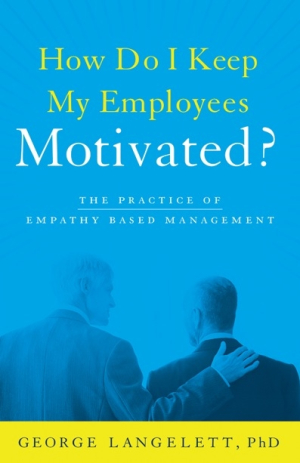How Do I Keep My Employees Motivated?
The Practice of Empathy-Based Management
- 2014 INDIES Winner
- Gold, Business & Economics (Adult Nonfiction)
- 2014 INDIES Winner
- Bronze, Psychology (Adult Nonfiction)
- 2014 INDIES Winner
- Honorable Mention, Self-Help (Adult Nonfiction)
- 2014 INDIES Finalist
- Finalist, Reference (Adult Nonfiction)
This outstanding book about managing with empathy is destined to become a business classic.
Many books have been written about employee motivation, but it is a rare title that suggests the real key to motivating employees has little to do with incentives or rewards. According to management and economics professor George Langelett, lasting and meaningful employee motivation stems from the manager’s ability to empathize. In How Do I Keep My Employees Motivated? Langelett writes that “empathy-based management … will allow you to connect with the hearts of each of your employees and create a work environment where they can be fully engaged, problem solve, and enjoy their work.”
Langelett’s approach should resonate with enlightened managers who realize that something is not right in the way American companies manage their people. Rather than blame managers, Langelett believes the lack of understanding as to what motivates employees is “a systemic problem within today’s corporate America, driven by ever-increasing expectations for continual growth in profitability.” In effect, it seems that companies have simply forgotten that they are run by people.
Langelett’s solution is to create an environment in which “workers feel unconditionally accepted for their own worth and human dignity.” In a beautifully organized, elegantly written argument, Langelett presents his case for empathy-based management. He begins, in chapter 1, with a working definition of empathy, drawing a distinction between empathy (understanding) and sympathy (commiserating). The author then lays the foundation for a deeper understanding of empathy by explaining how neuroscience supports the fact that “empathy builds connections between human brains.” He follows this in chapter 2 by clearly establishing “core goals” for empathy-based management. Goals such as “create an emotionally secure work environment” and “help people grow personally and professionally” really speak to the reasoning behind the concept.
In chapters 3 and 4, Langelett offers detailed guidance for applying empathetic techniques in two different common scenarios: during times of crisis and in everyday employee management. In both chapters, Langelett deftly explains concepts and illustrates them with specific examples, including simulated dialogue between a manager and employee. In a particularly fascinating section that should help managers understand an employee’s depth of emotions, the author addresses both verbal and nonverbal (body language) messages. “Conversation is 33 percent verbal and 67 percent nonverbal,” writes Langelett. In addition to offering tips to the manager for reading an employee’s body language, he suggests possible ways the manager can convey empathy via nonverbal behavior. Chapter 5, in which Langelett demonstrates how empathy-based management works in an organizational environment, is the culmination of the book. Again, the author writes with authority, including numerous examples and sample dialogue.
Langelett enhances the value of the book with several appendixes. The first, an educational overview of many management theories, is very useful in putting empathy-based management in context. He also includes three worksheets that reinforce the principles covered in the book, as well as an exhaustive list of recommended further reading.
The cover is eye-catching, and the supporting blurbs about the book are impressive. The interior is attractive, well designed, and easy to read.
In his conclusion, Langelett encourages the reader not just to apply the book’s principles, but to contact the author to let him know “what works and what does not work.” Langelett’s “open invitation to continue this conversation” clearly demonstrates his own empathy and keen interest in improving his methodology. This is a brilliantly conceived, researched, and constructed book every manager should take to heart.
Reviewed by
Barry Silverstein
Disclosure: This article is not an endorsement, but a review. The publisher of this book provided free copies of the book and paid a small fee to have their book reviewed by a professional reviewer. Foreword Reviews and Clarion Reviews make no guarantee that the publisher will receive a positive review. Foreword Magazine, Inc. is disclosing this in accordance with the Federal Trade Commission’s 16 CFR, Part 255.

